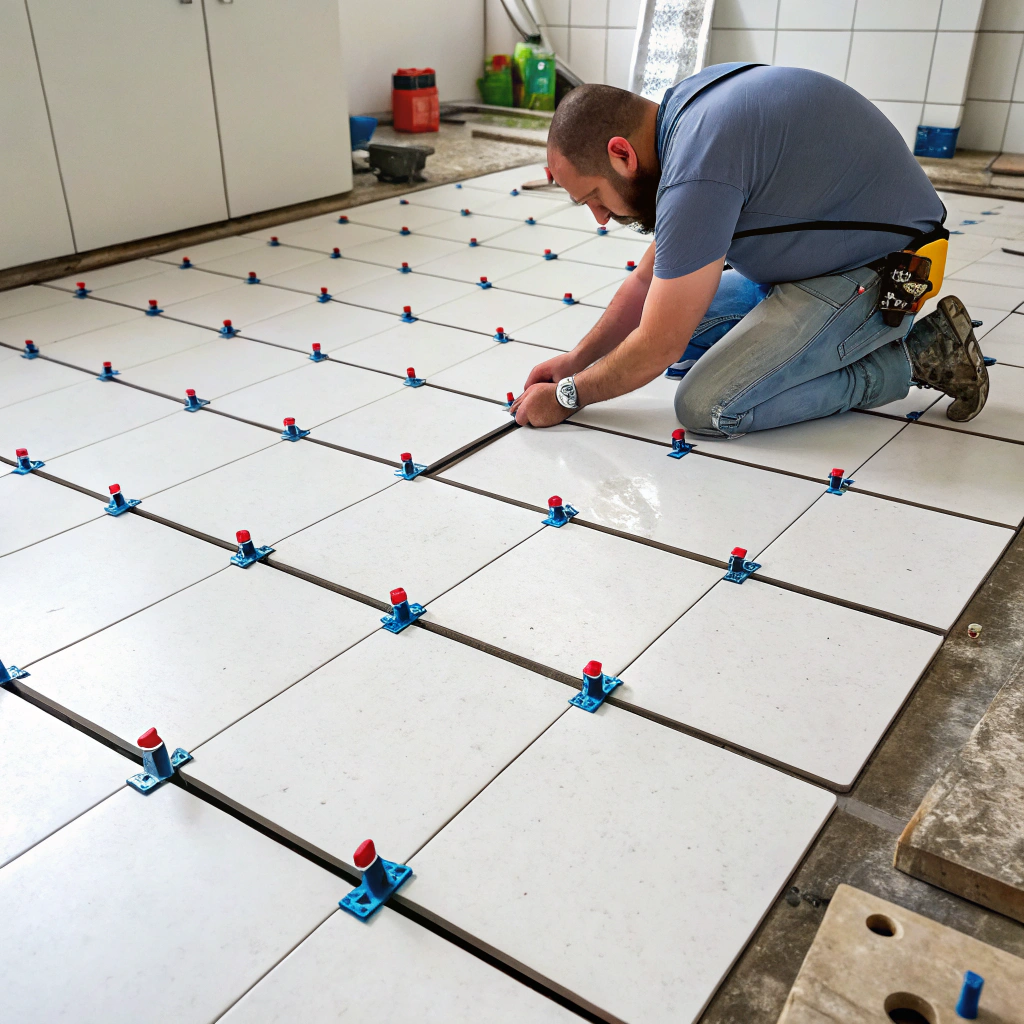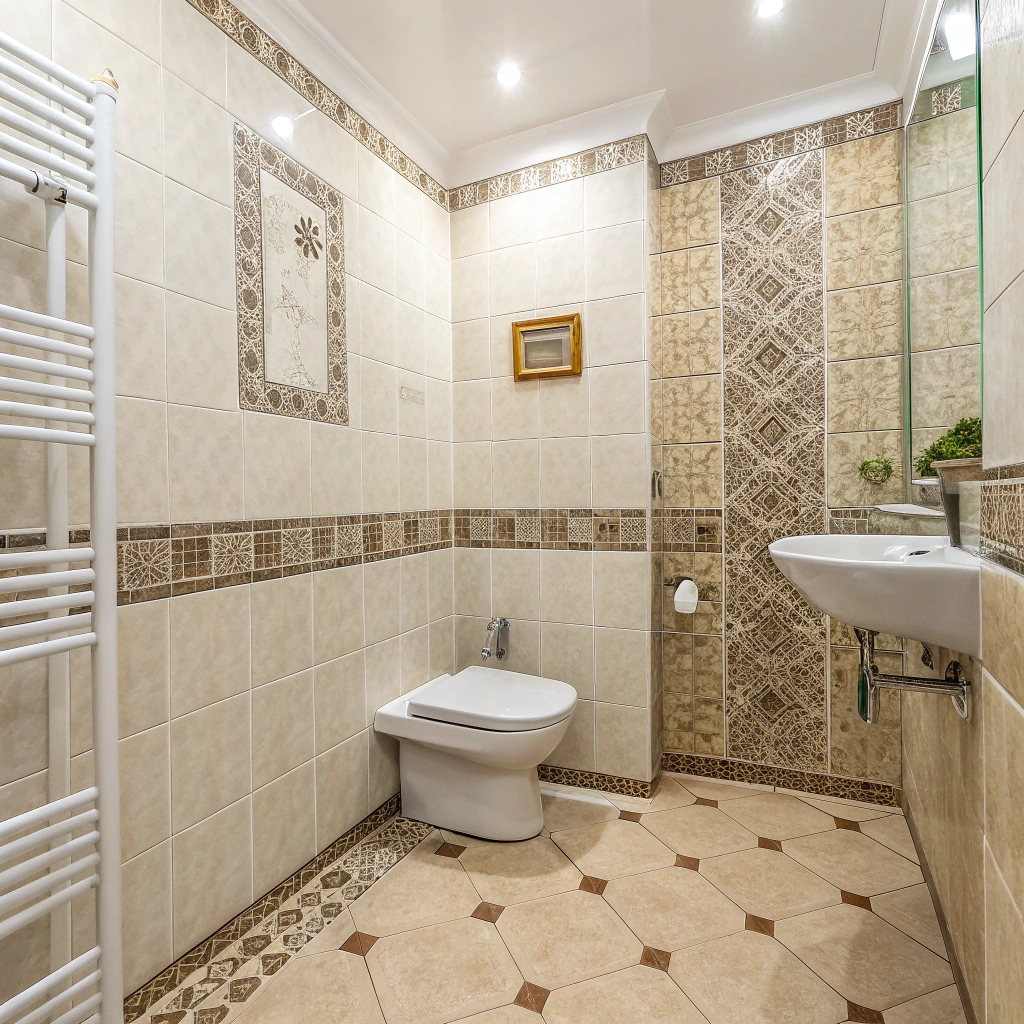Leitfaden für Fliesenabstandshalter: Alles, was Sie wissen müssen?

Beim Verlegen von Fliesen können ungleiche Fugen oder falsch ausgerichtete Ecken das Ergebnis ruinieren. Fliesenabstandshalter sorgen für perfekte Symmetrie und sparen sowohl Zeit als auch Geld.
Fliesenabstandshalter sind kleine Kunststoffteile, die zwischen den Fliesen verwendet werden, um gleichmäßige Abstände zu gewährleisten und so ein professionelles Aussehen zu erzielen. Außerdem sorgen sie für einheitliche Fugenlinien und strukturelle Integrität.
Die meisten Heimwerkerfehler beim Fliesenlegen entstehen, weil dieses winzige Werkzeug übersehen wird. In diesem Leitfaden erkläre ich Ihnen, was Abstandshalter für Fliesen sind, wie man sie verwendet und wann man sie weglassen kann.
Was sind Abstandshalter für Fliesen und warum werden sie verwendet?
Die Verlegung von Fliesen kann ohne Präzision schrecklich schief gehen. Ungleichmäßige Fliesen, krumme Linien und ungünstige Fugen sehen nicht nur unprofessionell aus, sondern schwächen auch die gesamte Fliesenfläche.
Fliesenabstandshalter sind unverzichtbare Hilfsmittel, um gleichmäßige Abstände zwischen den Fliesen für Fugen, Ausrichtung und langfristige Haltbarkeit zu gewährleisten.

Abstandshalter für Fliesen werden in der Regel aus hartem Kunststoff hergestellt. Es gibt sie in verschiedenen Größen und Formen wie T-Form, Kreuz oder Keil. Ich verwende sie jedes Mal, wenn ich Fliesen verlege, egal ob es sich um eine Badezimmerwand oder einen Küchenboden handelt.
Vorteile von Abstandshaltern für Fliesen
- Konsistente Fugenlinien: Abstandshalter sorgen dafür, dass alle Fugen gleich breit sind.
- Ausrichtung: Hält die Fliesen in geraden Linien.
- Zeitersparnis: Verringert Nacharbeit aufgrund von Ausrichtungsfehlern.
- Ästhetische Qualität: Erzeugt ein sauberes, professionelles Finish.
- Langlebigkeit: Richtige Fugen verringern die Rissbildung aufgrund von Ausdehnung oder Verschiebung.
Arten von Abstandshaltern für Fliesen
| Abstandshalter Form | Am besten für | Beschreibung |
|---|---|---|
| Kreuz | Quadratische oder gitterförmige Layouts | An den Schnittpunkten von vier Kacheln platziert |
| T-förmig | Fliesen mit Backsteinmuster | Wird verwendet, wenn die Fliesen versetzt angeordnet sind. |
| Keil | Unebene Oberflächen | Nützlich zum Nivellieren von Fliesen an Wänden oder unregelmäßigen Untergründen |
Die Wahl des richtigen Abstandshalters hängt von Ihrem Fliesenmuster ab. Ich verwende oft Kreuzabstandshalter für Standardmuster und Keile, wenn ich vertikal oder auf unebenen Wänden fliese.
Fliesenabstandshalter helfen, gleichmäßige und professionell aussehende Fugenlinien zu schaffen.Wahr
Sie sorgen dafür, dass alle Fliesen gleichmäßig verteilt sind, was zu gleichmäßigen Fugenlinien führt.
Abstandshalter sind optional und haben keinen Einfluss auf die Haltbarkeit der Fliesen.Falsch
Ungleichmäßige Abstände ohne Abstandshalter können mit der Zeit zu strukturellen Schwächen und Rissen in den Fliesen führen.
Welche Abstandshaltergröße ist ideal für verschiedene Fliesen?
Die Wahl der falschen Abstandshaltergröße kann entweder zu viel Fugenmasse oder sehr schmale Linien zur Folge haben, die mit der Zeit reißen.
Die ideale Größe des Abstandshalters hängt von der Art der Fliese, dem Standort und der bevorzugten Gestaltung ab - größere Fliesen benötigen oft breitere Abstände, während für kleinere Fliesen schmale Abstandshalter verwendet werden können.

Wenn ich an einem Projekt arbeite, stimme ich die Größen der Abstandshalter auf das Fliesenformat und das gewünschte optische Ergebnis ab. Hier ist eine kurze Übersicht über die gängigen Größen und ihre Verwendung.
Übliche Fliesenabstandshaltergrößen
| Abstandshalter Größe (mm) | Empfohlener Fliesentyp | Häufige Verwendungszwecke |
|---|---|---|
| 1-2 mm | Kleine Keramik/Mosaik | Badezimmerwände, Aufkantungen |
| 3 mm | Mittlere Fliesen | Fußböden, Duschwände |
| 5 mm | Großes Porzellan/Stein | Fliesen für den Außenbereich, Industrieböden |
Fugenmörteltyp berücksichtigen
Verschiedene Fugenmaterialien dehnen sich unterschiedlich aus. Wenn Sie zum Beispiel Epoxidharzmörtel verwenden, ist ein Mindestabstand von 3 mm erforderlich. Fugenmörtel auf Zementbasis können mit 2 mm Abstand gut funktionieren.
Tipps für die Wahl der Abstandshaltergröße
- Visuelle Präferenz: Größere Fugen zeigen mehr Fugenmasse, was sich auf das Gesamtdesign auswirkt.
- Material der Fliese: Natursteinfliesen benötigen aufgrund von Größenunterschieden oft breitere Fugen.
- Oberfläche Standort: In Nassbereichen wie Badezimmern sind möglicherweise breitere Fugen erforderlich, um die Fugen besser abzudichten.
Ich persönlich finde, dass 3 mm Abstandshalter die beste Balance für die meisten Anwendungen in Wohnräumen bieten.
Größere Fliesen erfordern in der Regel größere Abstandshalter.Wahr
Größere Fliesen benötigen mehr Fugenraum, um die natürliche Ausdehnung und Schrumpfung auszugleichen.
Sie können für alle Fliesentypen die gleiche Abstandsgröße verwenden.Falsch
Unterschiedliche Fliesen und Bereiche benötigen unterschiedliche Abstandshaltergrößen für optimale Leistung und Optik.
Wie platziert und entfernt man Fliesenabstandshalter richtig?
Man könnte meinen, dass ein Abstandshalter einfach nur zwischen die Fliesen gelegt wird. Aber wenn man es falsch macht, kann es das Layout beeinträchtigen oder das Entfernen erschweren.
Um die Abstandshalter richtig zu verwenden, setzen Sie sie nach dem Ausrichten von zwei Fliesen ein, stellen Sie sicher, dass sie bündig mit der Fliesenoberfläche abschließen, und entfernen Sie sie, bevor der Kleber vollständig getrocknet ist.

Normalerweise gehe ich folgendermaßen vor:
Schritte zum Anbringen von Abstandshaltern für Fliesen
- Thinset-Kleber auftragen: Mit einer Zahnspachtel gleichmäßig auf der Oberfläche verteilen.
- Legen Sie die erste Kachel: Stellen Sie ihn fest und prüfen Sie den Füllstand.
- Fügen Sie den Abstandshalter hinzu: Setzen Sie je nach Position der Fliese (quer oder hochkant) ein oder zwei Abstandshalter ein.
- Weiter kacheln: Legen Sie die nächste Fliese auf den Abstandshalter und passen Sie die Ausrichtung an.
- Wiederholen Sie das: Prüfen Sie regelmäßig den Füllstand und die Abstände.
Entfernen von Abstandshaltern für Fliesen
- Warten Sie nach dem Verlegen 24 Stunden oder bis der Kleber fast trocken, aber noch nicht vollständig ausgehärtet ist.
- Ziehen Sie die Abstandshalter mit einer Zange oder von Hand vorsichtig heraus.
- Reinigen Sie die Fugen mit einer Bürste, um sie für die Verfugung vorzubereiten.
Profi-Tipps
- Drücken Sie die Abstandshalter nicht zu tief ein; sie sollten leicht zu entfernen sein.
- Bei Wandfliesen sollten Sie die Verwendung von Abstandskeilen in Betracht ziehen, um die Höhe der Fliesen anzupassen.
- Prüfen Sie die Ausrichtung regelmäßig mit einer Laserwasserwaage oder einer Kreidelinie.
Wird die ordnungsgemäße Entfernung versäumt, kann dies beim Verfugen zu Problemen wie Klumpenbildung oder ungleichmäßigem Auftrag führen.
Die Abstandshalter sollten vor dem Verfugen der Fliesen entfernt werden.Wahr
Bleiben sie drin, können sie die Fugen stören und die endgültige Oberfläche schwächen.
Die Abstandshalter sollten dauerhaft zwischen die Fliesen geklebt werden.Falsch
Sie sind temporäre Hilfsmittel und sollten nach dem Aushärten der Fliesen entfernt werden.
Kann man ohne Abstandshalter fliesen - wann ist das akzeptabel?
Einige traditionelle Bauherren verzichten auf Abstandshalter. Sie argumentieren, dass erfahrene Dachdecker die Abstände mit den Augen sehen und nach Gefühl einstellen können. Aber ist das zuverlässig?
Sie können ohne Abstandshalter nur dann fliesen, wenn Sie rektifizierte Fliesen auf sehr flachen Oberflächen verwenden, und auch nur dann, wenn Sie viel Erfahrung mit der Verlegung von Fliesen haben.

In einigen seltenen Fällen können Sie die Abstandshalter weglassen:
Wann es in Ordnung ist, die Abstandshalter wegzulassen
- Rektifizierte Kacheln: Sie sind werkseitig auf exakte Maße zugeschnitten und scharfkantig.
- Dry Fit Praxis: Für dekorative Wände mit minimalen oder unerwünschten Fugenlinien.
- Qualifizierte Arbeitskräfte: Professionelle Fliesenleger mit jahrelanger Praxis können gleichmäßige Abstände nach Augenmaß erreichen.
Aber hier liegt das Problem. Selbst ein kleiner Versatz kann das ganze Muster durcheinander bringen. Ich musste schon Projekte reparieren, bei denen der Kunde darauf bestand, keine Abstandshalter zu verwenden. Das kostete sie zusätzliche Materialien und Arbeit.
Risiken bei Nichtverwendung von Abstandshaltern
- Ungleichmäßige Fugenlinien
- Schräge oder falsch ausgerichtete Fliesen
- Rissbildung aufgrund fehlender Dehnungsfugen
- Verfärbung der Fugenmasse durch ungleichmäßige Tiefe
Urteil
Es ist zwar möglich, aber ich empfehle selten, ohne Abstandshalter zu fliesen. Das Risiko ist es nicht wert, es sei denn unter sehr kontrollierten Bedingungen.
Nur rektifizierte Fliesen erlauben in bestimmten Fällen eine Verlegung ohne Abstandshalter.Wahr
Ihre präzisen Kanten ermöglichen minimale Fugenlinien und genaue Abstände nach Augenmaß.
Die Verwendung von Abstandshaltern ist nur für Anfänger geeignet und für Profis nicht notwendig.Falsch
Selbst erfahrene Fliesenleger verwenden Abstandshalter, um Genauigkeit und Geschwindigkeit zu gewährleisten.
Schlussfolgerung
Abstandshalter für Fliesen mögen klein sein, aber sie machen einen großen Unterschied. Ganz gleich, ob Sie auf Böden oder an Wänden, im Innen- oder Außenbereich arbeiten, die Verwendung des richtigen Abstandshalters sorgt für ein glattes, dauerhaftes und schönes Ergebnis.



